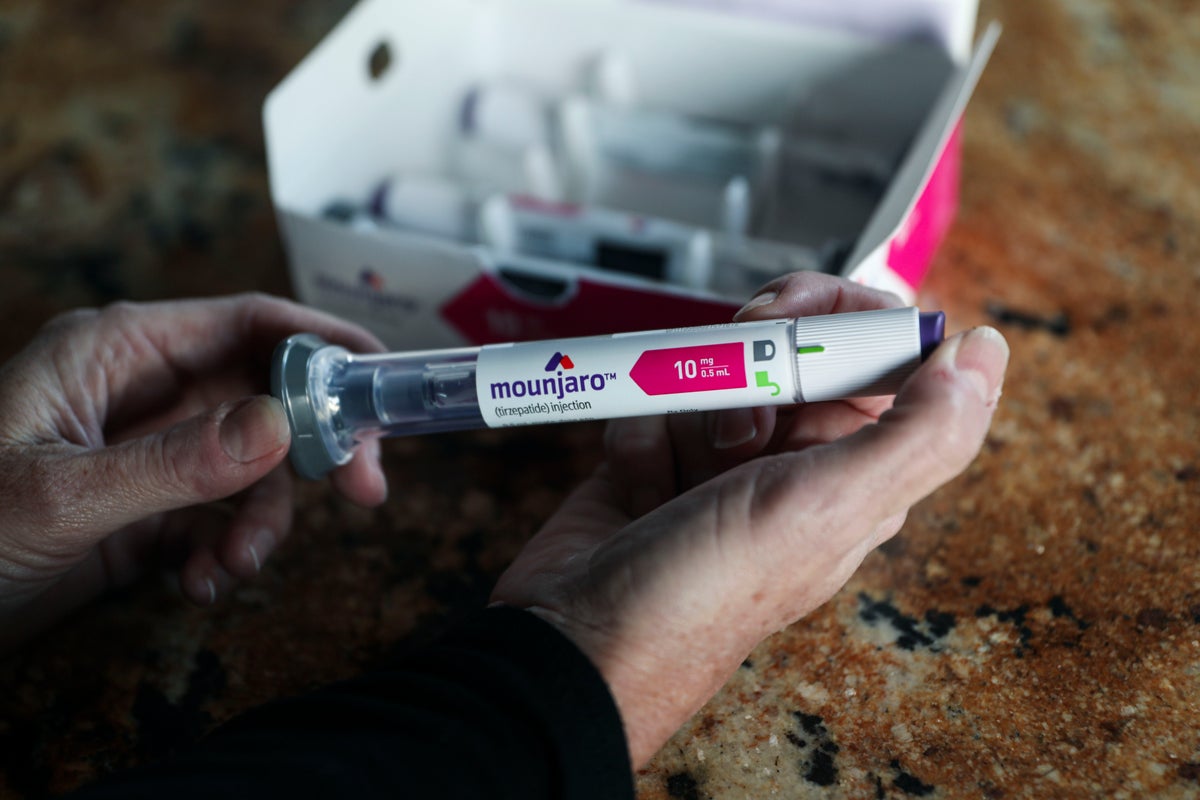
Kay thought she’d finally made it.
After years of diets, exercise routines, failed obesity treatments and shame for being overweight, the 49-year-old teacher from Missouri found a medication that helped her lose 25 pounds in three months. “It was life-changing,” she says.
In addition to shedding weight, Kay experienced other changes that seemed almost miraculous. She quickly noticed the painful cramping from her fibroids disappear and the swelling in her legs vanish. “I could go for walks again,” Kay told me. She even stopped taking Wellbutrin. “It became about far more than just weight loss.”
Then it was all taken away. The new diabetes drug Mounjaro was behind Kay’s weight loss, but when the manufacturer, Eli Lilly, changed its coupon terms her transformation became unaffordable — and unsustainable. If Kay wanted to continue to lose weight, live pain-free, and stave off a dreaded diabetes diagnosis, she’d have to shell out $1,000 every month – more than the mortgage on her house, and far more than the $25 per month she had been paying with Eli Lilly’s original savings program. Mounjaro, the name brand for tirzepatide, is one of a new class of nutrient-stimulated hormone-based therapies that’s changed the way type 2 diabetes (T2D) is treated. While similar therapies target a hormone called GLP-1, Lilly’s Mounjaro is the first to target a second hormone, GIP. Together, these hormones decrease appetite and delay gastric emptying, making a person feel full for longer. In a 2022 study on tirzepatide, participants saw an average weight reduction of 22.5 percent. In a separate study, Novo-Nordisk’s celebrity-endorsed Ozempic, which targets only GLP-1, showed an average weight reduction of 16.9 percent.
This critical side effect of Mounjaro — swift weight loss that rivals bariatric surgery — has made the drug a heated flashpoint between patients with diabetes, patients with obesity desperate to avoid a T2D diagnosis, people looking to improve their physical and mental health through weight loss, insurance companies, and Eli Lilly.
The conflict, which has been exacerbated by shortages of Mounjaro and two of its GLP-1 predecessors, Ozempic and Trulicity, has been intensified on social media. Diabetes patients think people with obesity are stealing their drug, as it’s currently only approved for the treatment of T2D (though FDA approval for the treatment of obesity may come as soon as this summer.) People with obesity are angry that obesity isn’t recognized as a disease. And users who can’t afford it say they’ve been abandoned by Big Pharma.
“I felt like a normal person for the first time in a really long time,” says Jordan Goodwin, a 30-year-old from Dallas who has polycystic ovarian syndrome, or PCOS. Goodwin lost 30 pounds with Mounjaro in three months before her coupon unexpectedly stopped working and the drug became unaffordable. “Now it’s all back — I’m insatiable. Should I let myself get diabetes so that I can get the medication that works?”
This is why Lilly’s decision to change its coupon terms hit patients so hard. “Not only were patients probably not aware that there was a time limit in the first place, but they moved the ball, so to speak,” Michelle Mello, a professor of Law and of Health policy at Stanford University, said. “They moved a goal-post up to create the dependence and then pulled the rug out even more quickly.”
Underneath that rug is a steep bill: Even when Mounjaro is approved for the treatment of obesity, it will cost about $13,000 a year. “It’s not, surprisingly, more cost-effective” than Ozempic, “even though it produces more weight loss,” said Dr. David Rind, the Chief Medical Officer for the Institute for Clinical and Economic Review.
As Kay’s and Jordan’s weight slowly creeps back up, they are unwilling participants of the phenomena of “yo-yo dieting,” or weight cycling, defined as repeatedly losing and regaining weight over a lifetime. Studies indicate that weight cycling adds stress to cardiovascular systems and affects psychological well-being. Weight cyclers are at risk for fluctuations in blood pressure, heart rate, and unstable levels of glucose, lipids and insulin, among other negative consequences.
Even people with diabetes, who for now are the only approved beneficiaries of Mounjaro, are finding the drug out of reach due to supply shortages, insurance denials, and out-of-pocket costs.
“In both populations, both people are losing out,” says Dr. Holly Lofton, the director of the weight management program at NYU Langone Health. “They’re losing out because they’re having inadequate glucose control and they’re having an increase in their fat cell size, which means they have increased inflammation. Even if their diabetes stays in remission, if they gain the weight back, that could still be causing them detriment.”
What was a miracle drug for many is now mostly inaccessible.
“If they were starting people on something that would be dangerous to stop, is that really an appropriate thing to do?” asked Carl Coleman, a professor at Seton Hall Center for Health and Pharmaceutical Law and Policy. “Is it appropriate to encourage people who otherwise wouldn’t be able to take it without a plan [without] making it possible for them to continue taking it?”
When Eli Lilly debuted Mounjaro in May 2022, it did so with a coupon that would allow anyone with commercial insurance to get Mounjaro for as low as $25 a month until July 2023, even if their commercial insurer didn’t cover it. Massive demand — fueled in part by social media success stories, the low cost, and by telehealth companies that were more than willing than traditional primary care physicians to prescribe Mounjaro off-label — caught up with supply. In November, without warning, Eli Lilly then changed the terms of the coupon, resulting in mass confusion and vitriolic encounters both online and in pharmacies nationwide.
“The manufacturer never made any kind of announcement there was a change to the terms and conditions,” Sara, a Walmart pharmacist in Alabama, says. “I was basically having to snoop on online forums to figure out what was going on.”
What Sara discovered was that Eli Lilly’s “new” coupon required patients to attest to a
T2D diagnosis. The new discount price was jacked from $25 to $500, but only for those whose insurance covered Mounjaro. Otherwise, the miracle drug would cost about $1,000 per month.
“Lilly’s savings program for tirzepatide is only intended for commercially insured adult patients in the US who have a type 2 diabetes diagnosis and have been prescribed tirzepatide within its marketing authorization (“on-label”),” said a spokesperson from Eli Lilly. “We have reinforced this intended use through the addition of a patient attestation highlighting a type 2 diabetes requirement on the savings program page, as well as recent changes to the program’s terms and conditions in November 2022 and again starting in January 2023.”
Customers erupted when their coupons abruptly stopped working, begging Sara to find a way to preserve the old coupon price. She absorbed the patients’ frustration with Lilly and their insurers: “Don’t they want to keep me from getting diabetes?” they would ask, again and again.
“Patients felt we fabricated the whole shortage thing,” says Matt, a pharmacist from Indianapolis who works at a major retail pharmacy chain. “One woman said, ‘You’re denying me my medication. You don’t want me to have it.’ And then she threatened to sue us.”
In the gladiator pits of Reddit and Facebook, patients with obesity and those with diabetes cross swords over who has more of a right to Mounjaro.
“I don’t like the anger that a lot of the weight loss community is displaying towards diabetics,” Lauren Rogers, a diabetic from Wheeling, West Virginia, said. “They say, ‘We deserve to lose weight and Mounjaro isn’t going to help you control your blood sugar,’ and ‘Just go on some other diabetes drug.’ It’s really painful.”
Diabetics blame those with obesity for creating the supply issues with Mounjaro, while those suffering from obesity want it recognized as a disease, and not some moral failure. They resent hearing they don’t merit such medication, citing Mounjaro as preventative medicine. Obesity diminishes the quality and length of life and is linked to diseases including diabetes, heart disease, and some cancers.
“Obesity is not a choice. Obesity is a complex, chronic, neuro-metabolic disease with a clear pathophysiology,” said Dr. Ania Jastreboff, an endocrinologist and obesity medicine physician-scientist at Yale University and lead author of a paper showing tirzepatide’s superior efficacy against obesity.
When someone takes an anti-obesity medication like Mounjaro, the amount of fat the body wants to maintain is re-regulated, usually to a lower weight. “When you take the medication away, that defended fat mass goes back up, and weight is regained,” Jastreboff said. “In order to continue to maintain the new re-regulated defended fat mass, and weight reduction, you have to continue taking the medication.”
“We are working to ensure people with type 2 diabetes can continue filling their prescription as normal,” said a spokesperson from Eli Lilly. “We remain committed to ensuring people with type 2 diabetes who are on tirzepatide (Mounjaro) receive their medicine.”
Due to shortages, Rogers had to stop taking Mounjaro for three weeks. “I was a wreck over it and full of despair,” said the 58-year-old. “I gained several pounds back, but I was surprised at how badly I felt when my [blood glucose] numbers got out of control again. It was a wakeup call to me to realize how sick diabetes makes you.”
Amid all the complaints, Mounjaro looks like a gold mine. “We’re modeling for 2024, worldwide sales of $4.7 billion,” said Geoff Meacham, an analyst with Bank of America. Colin Bristow, an analyst at UBS, predicted Mounjaro will be the best-selling drug of all time. “Our current estimate for sales for Mounjaro is around $30 billion by the end of the decade,” he said.
“Mounjaro is a game changer and that’s not an exaggeration,” said Paul Ford, a 53-year-old former firefighter who lost 30 pounds and says he no longer needs to use a CPAP machine to sleep. “I feel so much better. I haven’t felt like this in years. If I had felt like this when I was a firefighter, I would’ve stayed with it longer.”
Mounjaro may very well turn out to be one of the most lucrative pharmaceuticals ever, with the potential to radically change tens of millions of lives for the better. But for many of the drug’s early adopters, Mounjaro’s promise has set them up for another round of weight gain, co-morbidities and despair.
“It’s almost worse knowing it’s there, but just out of reach,” Kay said. “Lilly could have put some solutions in place for people who had already started the drug.” For now, she lives in uncertainty, with no guarantee that she will be able to access the medication again.







